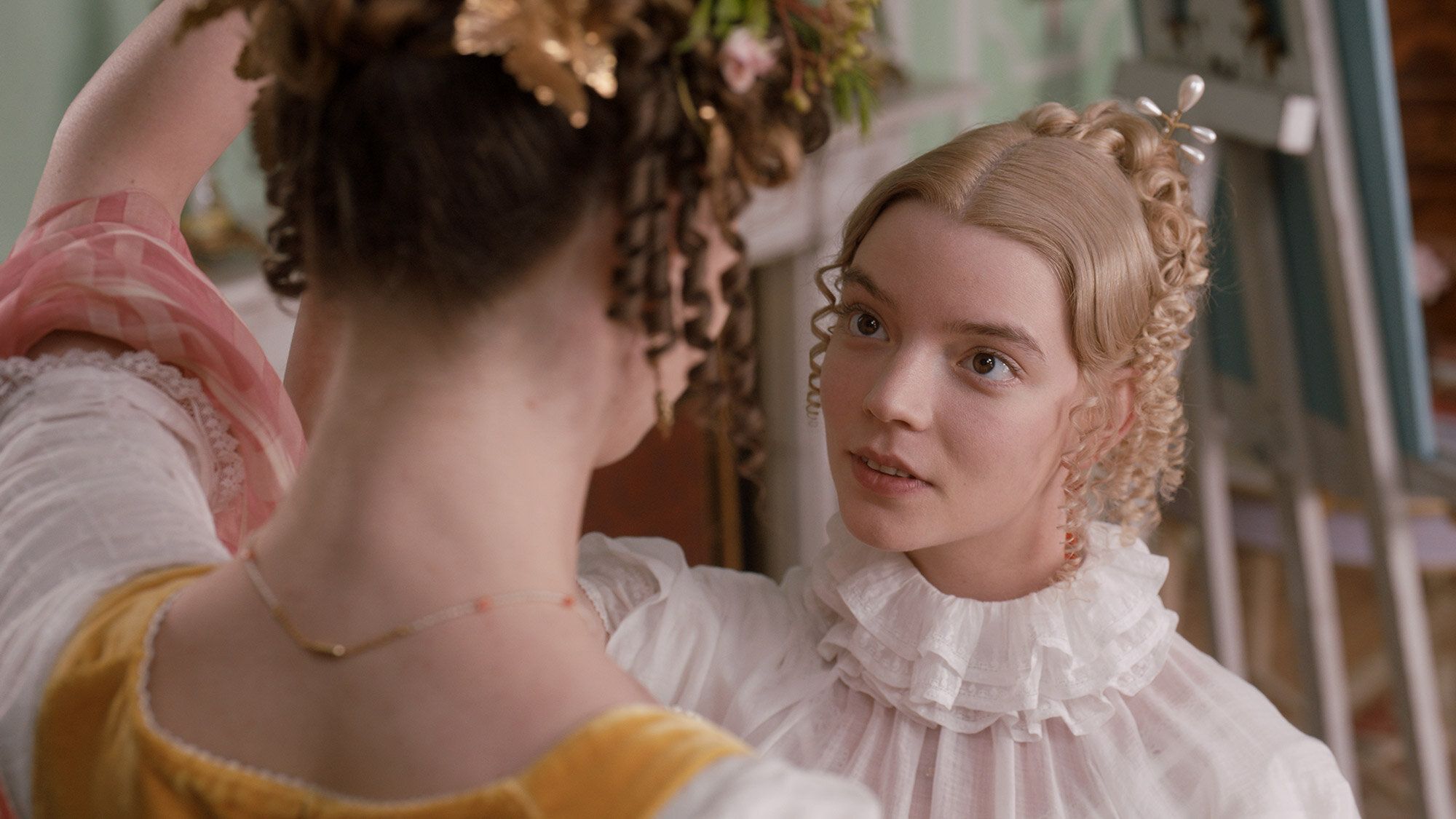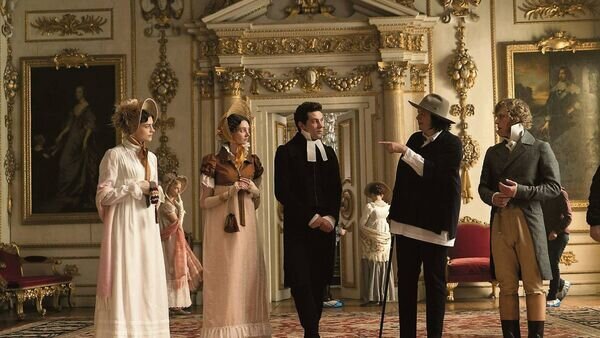Emma and the Power of the Queer Gaze
Few films caused a stir quite like the evocative adaptation of EMMA. by Autumn de Wilde did, in the chaotic year that was 2020. And for good reason. She interweaved the thread that other adaptations lacked (such as Clueless or 1996’s Emma starring Gwyneth Paltrow), revealed in longing filled glances, and misplaced affections.
In short, de Wilde unveiled the thread of desire, weaving it subtly, and in every pore of the film. The thread of desire, and specifically, the thread of desire between women. As an adaptation saturated by queerness, de Wilde asserts not merely the possibility, but reality, of Emma’s bisexuality; as we are invited to witness the power of the queer gaze in all its glory.
But what exactly is the queer gaze? When defining this term, it is first necessary to define the male gaze and its relationship to the queer one. Coined by Laura Mulvey in her 1975 essay “Visual Pleasure and Narrative Cinema” (47-8), the male gaze is defined as the following:
“The determining male gaze projects its fantasy onto the female figure, which is styled accordingly. In their traditional exhibitionist role, women are simultaneously looked at and displayed, with their appearance coded for strong visual and erotic impact so that they can be said to connote to-be-looked-at ness.”
That is, the director and assumed audience is male, and the conventions of cinema (shot type, dialogue, often one-dimensional portrayal of women) are created with this specter of patriarchy hovering over it – specifically, for male pleasure. Subsequently, the straight gaze is often used in relation and tandem to the male gaze. Here, it assumes heterosexuality to be the default, in which heteronormative, patriarchal depictions on screen are upheld and perpetuated with straight men as the basis of interaction and viewership. In turn, this creates the binary of self/Other; excluding the experiences of women and queer people in the process.
However, this default setting was challenged with the development of feminist and queer studies, wherein queer theory has its roots, propelling both the female and queer gaze to emerge. Coined by Teresa de Lauretis, queer theory formally begun in the 1990s, and was propelled by other academics such as Judith Butler and Eve Kosofsky Sedgwick. Here, the term queer is multifaceted, as it refers to both queerness in gender presentation (that is, gender presentation that falls outside of heteronormative categories, i.e gender-queer, non-binary, and transgender identities) and sexual orientation (sexuality as fluid and shifting, encompassing gay, lesbian, and bisexual nuance).
Queer theory examines the behaviors, actions, and identity surrounding LGBTQIA+ people, both in person and on-screen. In the latter, interrogating the way in which characters are inherently queer coded, that is, how gay and sapphic figures and identity is portrayed in literature, film, and television.
What is the queer gaze? Well, the queer gaze can be defined as the gaze which does not assume the spectator is straight nor traditionally gender presenting/identifying. Refreshingly, it goes beyond the male vs female gaze framework, which still uses heterosexuality as the default setting, and instead assumes queerness as its basis, instead. Wherein, the queer gaze disrupts, challenges, and subverts the patriarchal, heteronormative conventions in an intersectional manner; allowing diversity to direct the work. Which in turn, provides much-needed representations of queerness in popular culture.
Notably, both de Wilde and Austen contrive relationships in a seemingly heteronormative fashion. Of frivolous social relations that uphold the patriarchy and status quo, that are flippant and vain. It is for this reason that Emma, both as a protagonist (played by the stunning Anya Taylor-Joy in this version), and as a novel/film, has always been so profoundly misunderstood. However, de Wilde’s potent adaptation boldly leads us to what the novel renders implicit; that the neatness and rigidity of the relationships between Jane Fairfax and Frank Churchill, (played by Amber Anderson and Callum Turner), between Mr. and Mrs. Elton (played by Josh O’Connor and Tanya Reynolds), between Emma’s sister and her husband, between Harriet Smith and Robert Martin (played by Mia Goth and Connor Swindells) are in fact perfect parcels of the status quo, and that because of this, are but a mere farce, a parody, a comedy of errors.
What Austen contrived is a level of subversion that lays just beyond the surface of what you see, that we, as queer people, know all too well. Austen and de Wilde critique the heteropatriarchy by illuminating the incredulity of gender roles and heteronormative sexuality. After all, it is Austen (339) herself who decreed in this text, that "very seldom does complete truth belong to any human disclosure seldom [is] something not a little disguised, or a little mistaken.”
This is present from the outset of the film. From the very setting of Highbury in the Hartfield residence, the lavish mansion acts as a conspirator, oppressing the characters of their affections. As does the beautiful Regency era clothing, – full of tantalizing corsets and tight cravats which repress, stifle, and disguise this desire. A desire that has to be subdued and subtextual, because it is subversive. It is a story which at its core is desire between women in which everything else is secondary.
Notably, it is these assumed binaries that are all disrupted by the protagonist of the film, the young heiress, Emma Woodhouse. She takes great glee in contriving these pairings through her match-making skills, in a double effort to both undermine these normative relations, and conveniently pursue her main passion: the courting of female companions.
From the film opening sequence, Emma is defined by her relations to women. We are met with flashes of grief at the wedding of her long-time companion, Mrs. Taylor (played by Gemma Whelan) before the film introduces us swiftly to her courting her next female companion: Harriet Smith.
This is both covert and overt in nature. Emma is seen brooding over Harriett in their parlor, courting her at her room and board, insisting on their daily walks, and, of course, via her open disdain for marriage. Yet it is also overt in Emma’s vehement control of Harriett’s love life, as we see her boldly contrive her never to-eventuate relationship with Mr. Elton in the drawing-room blunder. Which Austen (60) describes as an “alliance” which “can never raise a blush in either of us” and will "confirm [their] intimacy for ever.”
Even more conspicuously, in the row between Mr. Knightley and Harriet, as we see Anya Taylor-Joy and Johnny Flynn move from room to room throughout their disagreement, as Knightley insists on Harriet’s lower societal status. It is only when Emma fiercely reproaches him in a zealous argument that the truth of the matter comes to the forefront. When a distraught Joy yells explosively, “I am done with match-making, I only want to keep Harriet for myself!”
But what about Mr. Knightley and Emma's relationship? Surely, he re-establishes the heteronormative parameters Emma originally disrupted. But this, I argue, is actually the power of de Wilde’s adaptation. Where other interpretations dismiss Harriet altogether, de Wilde forces us to recognize the intimacy of falling in love, as we bear witness to the trials and tribulations of this experience. Whether we see Emma falling for Harriet – or (spoiler alert) – Mr. Knightley, there is the shock of infatuation, the denial, the jealousy, the anger, the grief, and finally, there is acceptance. As de Wilde herself notes, “The movie is very much supposed to play into everyone’s memory of that best friend that maybe we should have kissed.” And the joy of Emma is that we get to witness this in all its queerness.
And de Wilde spares no detail. We are transported to Emma grinning with Harriet as they dance together in her bedroom, to quarreling over her with Mr. Knightley, to admitting her control fuelled jealousy in a confrontation over her suitors. Likewise, we see Emma verbally spar with Mr. Knightley, meet each other's eyes with longing-filled gazes as they finally touch at the ball, or confess his affections through the swoon-worthy line “If I loved you less, I might be able to talk about it more.”
This is what makes de Wilde’s interpretation revolutionary. We are not faced with the looming threat of the “bury your gays” trope, or homophobia, or exile. It is merely Emma’s realization that she loves women and men. That is her central struggle throughout the film. Wherein, tropes of bisexuality are just not engaged with, period, Emma’s queerness is not bated, no one cheats, and dating women is not seen as a lesser alternative to dating men.
Instead, we see Emma fall in love with women first, and only when she confronts and accepts herself, does she fall in love with a man. As de Wilde notes, “The relationship between Emma and Harriet is the first love story. Until she realized how much she loved Harriet and couldn’t live without her, she was able to love Mr. Knightley properly” (Gilchrist). Reflecting Austen’s (39’s) profoundly beautiful notion that perhaps “there may be a hundred different ways of being in love.”
Like Emma, we are dared to be vulnerable. To look and to be looked at in return. We are dared to love who we love and to accept all the messy and complicated and beautiful parts of ourselves with as much nuance and tenderness as we afford to her character. It is as subtle, and as profound, as that.
Sources:
Mulvey, L. “Visual Pleasure and Narrative Cinema.” Screen, Oxford University Press, 1975, p.47-8.
Austen, Jane. Emma. Oxford University Press, 2003.
EMMA. Directed by Autumn de Wilde, Perfect World Pictures, 2020.
Little, FH. “Meet the Stars of the Sumptuous New Emma.” Vogue, 15 Jan. 2020, https://www.vogue.com/article/anya-taylor-joy-johnny-flynn-emma-adaptation.
Gilchrist, T. “The New Emma Leans Into Queer Love and Modern Ideas of Marriage.” The Advocate, 20 Feb. 2020, https://www.advocate.com/film/2020/2/20/new-emma-leans-queer-love-and-modern-ideas-marriage.







